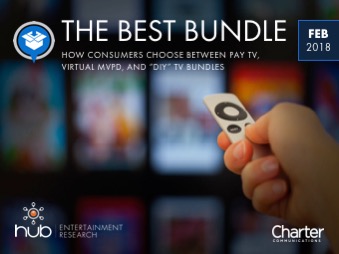The traditional MVPD bundle has been the target of much criticism over the past several years. For one thing, research has demonstrated that MVPD subscribers watch only a small portion (fewer than 10%) of the networks they have available. And that has contributed to a perceived “value-for-the-money” rating that is consistently lower for MVPD providers than it is for platforms like Netflix.
One result: consumers now create their own TV bundles, usually by combining pay TV with an assortment of online TV services, and using them to complement each other. (As of December 2017, the average pay TV subscriber also uses 1.9 online services in addition to their pay TV service.)
But we’ve seen evidence recently that consumers may be approaching platform saturation: more respondents in our studies say that they have so many options for TV that it’s hard to know where to begin. What’s more, consumers have shown enthusiasm for integrated solutions like Amazon Channels or having Netflix incorporated into Xfinity’s set top box – things that make TV simpler to navigate, without needing to manage multiple accounts and credentials.
“The Best Bundle”…
- Explores the current state of consumer preference for aggregated vs. standalone content
- Identifies the content and features that make bundles most appealing
- Tracks the findings against our 2017 bundling study (“Let’s Get Ready to Bundle”) to see how preferences are changing over time
- Gauges the opportunity for new/different approaches to bundling (e.g. Amazon Channels, pay TV add-ons like AMC Premiere or FX Plus)
- Measures the appeal of new standalones that may enter the game (e.g. Disney, Apple, etc.)
Online survey with 2,056 U.S. consumers age 16-74 who have broadband access at home and watch a minimum of 1 hour of TV per week.
